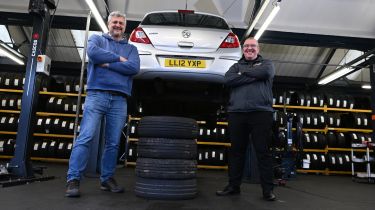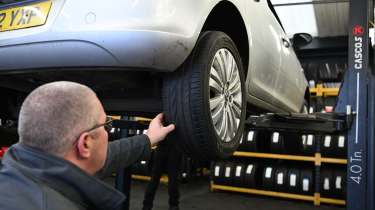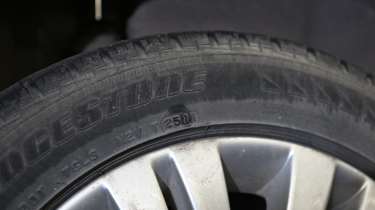Are part-worn tyres safe? Exclusive investigation, test and buying advice
We mystery shop part-worn tyre retailers, and explore the dangers of a lucrative trade

It’s estimated that between six to eight million part-worn tyres are sold here in the UK each year, and with global inflation sending the price of new tyres soaring, it’s no surprise that demand for part-worns is booming.
Part-worn tyres destined for the UK’s roads are shipped over by the containerload from northern Europe, adding to those removed as used items from customers’ cars by new tyre retailers here in the UK and sold into the part-worn market. Often part-worn tyres may be recovered and resold by vehicle dismantlers from worn out or scrap vehicles.
Sadly, although laws regulating the suitability and sale of part-worn tyres do exist, official oversight and enforcement are almost non-existent. As a result, horror stories are rife of dangerous and illegal tyres being sold to unsuspecting drivers as part-worns.
The significant potential dangers associated with buying damaged or defective part-worn tyres, or mixing tyres of different types or condition at each corner of your car, are proven. Unfortunately, many of those risks are not particularly understood by drivers, or may be overlooked by cash-strapped consumers. Tread depths that may typically range from 2mm (the lowest the law allows for a legitimately sold part-worn) to 5mm mean part-worns may not provide the greatest value in the long term compared with the 8mm tread on a new tyre either, but they can keep you legal at MoT time.
Worn tyres are not intrinsically dangerous of course, and most of us drive on them safely every day. In fact, you can reasonably wear a set of decent tyres down to the legal minimum tread depth of 1.6mm, although it goes without saying you must expect some deterioration in wet braking and handling performance as the tyres wear down. That's why many tyre professionals feel justified in recommending that you invest in a new set of rubber when your tyres have worn down to a tread depth of 3mm.

Although rules do exist around the supply and marketing of part-worn tyres, enforcement of the regulations is left to hard-pressed local authority Trading Standards departments. Perhaps it’s symptomatic of ‘broken Britain’, but when we tried to report the findings of our own investigations to Warwickshire Trading Standards, which the council’s website states has to be done via the Citizen’s Advice service, the relevant online form wasn’t working and we were kept on hold for 10 minutes before finally getting through to an advisor. Whether a public-spirited consumer might have hung on that long is a moot point.
Industry professionals have likened the market for part-worns to the Wild West, and say it’s in dire need of a sheriff. Indeed one trade body, the National Tyre Distributors Association, reckons the situation is so bad that part-worn tyre sales should be banned outright. It says the absence of enforced regulation means unsuspecting consumers are being put at risk through the sale of unsafe tyres that are fit only for recycling.
Part-worn tyre regulations
The regulations are actually really clear about the remarketing of part-worn tyres and, in theory, the Motor Vehicle Tyres (Safety) Regulations 1994 (part of the Consumer Protection Act), leave little room for dodgy rubber to be sold for road use.
Most importantly, the structural integrity of any tyre sold as part-worn must not be compromised, and to that end it must be inspected both externally and internally to ensure it is free of cuts, bulges or lumps. No plies or cords should be exposed, and the tyre must also pass an inflation test.
The minimum amount of tread that can be present on a part-worn tyre offered for sale is 2mm across the full width of the tyre, and the original grooves must be clearly visible in their entirety. In order to help reassure buyers that an inspection has been carried out, there is a legal requirement to permanently mark the tyre as ‘PART WORN’ in upper-case letters at least 4mm high, alongside the relevant ‘E’ mark.
Exclusive part-worn tyres investigation
Tyre industry charity Tyresafe is one of the voices seeking to raise awareness about the safety issues around part-worn tyres. To help us get a feel for some of the problems on the ground, we met up with Tyresafe representative Jason Simms to ‘mystery shop’ a couple of part-worn retailers in the Midlands.
First, we needed a suitable test car, so roped in a staff member’s ageing Vauxhall Corsa and thanks to Protyre Autocare in Warwick had it fitted with a set of barely legal tyres that would definitely have generated four advisories at MoT time. Protyre fits more than two million new tyres annually at 184 outlets across the UK and is a multiple winner of Tyresafe’s Retailer of the Year award. It also stood by to provide a professional expert assessment of the part-worn tyres we would return with.
We opted to shop for tyres at a couple of well advertised and seemingly popular businesses in the area. First up was Leamington Spa’s Spa Tyres, where our budget of £35 per tyre led to the Corsa swiftly emerging with a pair of remarkably fresh-looking Goodyear all-season tyres on the front axle. From there we hot-footed it to Cheapest Tyres in Coventry, where our potential MoT failures at the rear were replaced by a pair of Lassa Imperial winter tyres (Lassa is a Turkish subsidiary of Bridgestone), again with plenty of tread.
The service at both businesses was prompt and polite, and we saw fitters at both carrying out the required inflation tests. Most customers would be oblivious to the absence of legally required PART-WORN markings on the tyres we bought (markings intended to provide reassurance that tyres have been inspected as per the legislation) and would have driven away from both retailers feeling pretty pleased.
But on returning to Protyre for an expert inspection of our purchases, it quickly became apparent that there’s a lot more to part-worn quality assessment than meets the layperson’s eye. Protyre area manager Simon Hall whipped our Corsa up on the car lift, before carefully exploring the tyre treads and sidewalls, looking for any external irregularities or defects. Then all four tyres were removed in order that the internal sections of the tyre could be inspected.
The verdict? Simon reckoned our replacement Goodyears looked “nearly new”, and couldn’t be faulted for damage or defects. “It's difficult to say that wasn't a good buy at 35 quid each for two virtually brand-new Goodyear all seasons. You could see why someone would go for it,” said Jason, and our Corsa’s owner did exactly that, happily leaving them fitted to the car.
Age related tyre damage
Sadly the news was less positive when it came to the Lassa tyres from Cheapest Tyres. Spinning them while on the lift revealed external signs of delamination, which presents as unevenness in the tread. It’s hard to see with the car on the ground, but was immediately spotted by Simon with 15 years in the tyre trade under his belt.
“Straight away, there’s a raised edge on the inner where the carcass is starting to break down”, said Simon as he ran his hand over the surfaces during his internal inspection. “I think it's just down to age, where the carcass is starting to break down, but when I felt around the tyre, I noticed that defect straight away.”

Jason agreed the findings reinforced the need for expert checks. “The chance of Joe Punter having an eye for that sort of damage, or doing those checks is very doubtful,” he said. “That’s the kind of test that the part-worn retailer is supposed to assure you they’ve done by putting the PART-WORN mark on there. It says ‘we’ve done an inspection, and this tyre is safe’.”
The Lassa tyres were eight years old, according to their 2016 production marking, which also troubled our professionals, but in fact there’s no age limit specified in the regulations. This is because age-related damage depends to a large extent on how tyres have been stored or used, rather than their production date.
“This is exactly why it's been so difficult to persuade legislators, or even to convince the tyre industry, that there’s an age at which you should change them,” Jason told us.
Need for tougher regulation
With the part-worn tyre industry dealing with huge stock turnover nationally, there’s a big question around its capacity to provide the training and resources required to adequately assess the quality of tyres it’s reselling. The sheer scale of the market is impressive, but the budget-priced business model and lack of stringent enforcement of regulations suggest training may not be high on the agenda for all.
The absence of PART-WORN markings on tyres from both outlets we mystery-shopped doesn’t mean they hadn’t carried out an inspection, but in at least one of the instances any inspection that did happen failed to pick up a significant fault. When it came to the nearly new Goodyears, some legally required PART-WORN markings might have given us confidence that we didn’t just get lucky.
Spa Tyres told us they do mark tyres PART-WORN, but mistakenly forgot the stamp on our visit. “We will make sure it doesn’t happen again,” a spokesman pledged. “We take all the regulations very seriously and do our best to provide five-star service to all customers, as you can see from our reviews.” Cheapest Tyres of Coventry did not respond to our request for comment on our findings.
Witnessing the inflation tests showed staff had some level of training at both outlets we mystery shopped, but across the part-worn tyre trade as a whole that’s not always the case. “The trouble is you can set yourself up for 150 quid, go around the local tyre fitters offering to take their used tyres off their hands, and start making money very quickly. You can get yourself some premises, and then you’re off,” Jason told us.
That easy entry to the part-worn trade, plus the lack of meaningful oversight, means only one thing for drivers tempted by cut-price part-worn rubber: caveat emptor, or buyer beware.
Part-worn tyres tested vs new tyres
To demonstrate the difference between worn and new tyres, Auto Express was invited to the wet handling area at UTAC’s Millbrook proving ground in 2024 to compare the braking and handling of two identical Ford Pumas. One Puma was fitted with a brand-new set of Continental SportContact 7s, while the other Puma had the same tyres shaved down to the UK legal minimum tread depth of 1.6mm. Both cars were fitted with telemetry to compare emergency braking distances from 70mph and 60mph to a stop on a wet surface.
Telemetry data showed that from 70mph, the stopping distance on cold, wet tarmac was 60.7 metres for the car on new tyres, and a staggering 75.6 metres on the worn tyres – that's 14.9 metres further, equivalent to three-and-a-half car lengths. From the driver's seat, the Puma with worn tyres felt less controlled under braking, with the traction and stability control working harder to keep the car on course.

The outcome from 60mph was similar. On new rubber the car stopped in 42.6 metres, while the worn tyres had a stopping distance which exceeded 55.1 metres. No data was collected for the handling test, but it was clear the worn tyres were lacking in grip, leading to excessive understeer on tight corners.
Part-worn tyres could provide a short-term solution for motorists looking to replace their old, cracking, balding or low-on-tread tyres, for safety reasons or to pass an MOT, but they’re certainly not without risk.
Should you buy part-worn tyres?
There are a number of risks involved when buying part-worn tyres, so it is generally advised that you avoid buying second-hand tyres when the time comes to replace the rubber on your car.
The reality is that part-worn tyres are a gamble, even in the best-case scenario. With unknown history and the potential for failure, you could be taking your life and that of others into your own hands. What could be a potential saving in the short-term could pay back dearly in the future.
Why buy part-worn tyres?
The only real reason for buying part-worn tyres is to save money. According to a 2023 survey from online retailer eBay, 39 per cent of drivers say they will only replace their old tyres if they cause the car to fail an MOT, while 27 per cent admit to waiting ‘several months’ to replace a tyre that’s been issued with an MOT advisory warning. More alarmingly, 11 per cent of drivers who receive an MOT advisory warning said they would delay replacing the tyre until the tread fails the next MOT.
The figures also suggest that one-in-ten drivers have delayed the purchase of new tyres at some point in the previous three years due to financial pressures.
What are the risks of part-worn tyres?
Regulations surrounding the sale of second-hand tyres in the UK are fairly straightforward.
- Part-worn tyres should be in a good condition, with no large cuts in the tread, no bulges in the sidewalls and the chords and structural carcass should not be visible.
- Tyres should have at least 2mm of tread across the width and around the circumference.
- Part-worn tyres should be permanently marked as ‘part-worn’ in upper-case letter on the tyre sidewall, with the text being at least 4mm in height.
Even if part-worn tyres have plenty of tread to pass legal scrutiny, the quality control between part-worn tyre vendors will be variable at best. Some sellers are willing to flaunt the rules listed above, while others won’t be as bothered about issues such as damaged sidewalls, tyre puncture repairs or uneven wear.
Part-worn tyres also have an unknown history. Has the car they were previously fitted to been involved in an accident? Were they removed for safety reasons by the previous owner? Have they previously been repaired? These are important questions which the seller may not be able, or willing, to provide answers to. It all adds to the uncertainty and risk.
Brand-new tyres typically have a tread depth of between 8-9mm, so a part-worn set may, at best, have a few millimetres less than a brand-new equivalent. As a result, the braking and cornering grip produced by a second-hand tyre will be less, especially in wet and cold conditions. This could be the difference between avoiding a collision or not.
It’s worth noting that while part-worn and second-hand tyres may offer a cost-saving when compared to a brand-new tyre, the likelihood is that you will need to replace a used tyre more frequently.
Part-worn tyres: buying advice
If you’re insistent that part-worn tyres are the way to go, the first thing we’d recommend is buying a well-know, famous brand, because at least you know the basic tyre will be constructed to a good standard. We’d also recommend buying them in pairs, so you can get two tyres on the same axle which should theoretically match. If you’re buying one tyre, it’s very unlikely that you’ll be able to find one that matches the other three on your car in terms of tread wear and depth.
Tyre tread wear
Tread wear is the key thing to inspect. If the tyre has hardly been used, then you could get plenty of mileage from it. But if the shoulders are worn, or there's uneven tread, then who's to say you won't be coughing up again in a few months when your car fails its MOT because the tyres are worn out?
New tyres have 8mm of tread on them, while most outlets and safety organisations recommend replacing your tyres when there's 3mm of depth left. Anything less than this isn't worth working with, and even if there's more tread than this, if it isn’t evenly worn across the tyre it’s best to look elsewhere.
Sidewall damage
If the tread is fine, it's time to check the sidewalls. If the tyres have come off a car that has been involved in an accident (again, how do you know if they have or haven't?), then there's a high possibility that the tyres may have been damaged in the incident. Perhaps bodywork has come into contact with the tyre or lateral forces have damaged the sidewall's construction.

Irrespective of this, sidewalls can be damaged simply by poor parking. Any cuts, scrapes or loose rubber on the sidewalls could be a portent of damage to the tyre's construction, so always inspect the inside of the tyre for a consistent look to the internal part of the sidewall, too.
Tyre repairs
Another issue is with repaired tyres. If a tyre has suffered a puncture caused by a nail, screw or other sharp object piercing the tread, then it can be repaired with a plug of rubber that seals the tread against leaks.
There's nothing wrong with these repairs, but where the tread has been punctured, there will be damage to the belts that help the tyres retain their shape. Some tyres are unable to be repaired, and those that are may be limited in their maximum speed rating. Again, check the interior carcass of the tyre for damage. If you're being thorough, then it's probably worth walking away from tyres that have any kind of damage to them, either inside or out.
Tyre age
There is no definitive tyre age limit, but when tyres get to around seven years old, the overall condition of the rubber deteriorates, leading to cracking and reduction in performance – even if there is a lot of tyre tread remaining on the carcass. So it’s best to avoid any tyres which were manufactured seven or more years ago.
To help you identify the age of a tyre, there is a coded date printed on the sidewall, with the first two digits representing the week of production during the year and the second two digits representing the year of manufacture. So a code of 4122 would mean that tyre was manufactured in the 41st week of 2022.
If a tyre only has a three-digit number printed on the sidewall, it means that tyre was manufactured before the year 2000 and should be avoided. Our guide to tyre markings explains more.
Part-worn tyres: top tips
If you’re set on buying some part-worn car tyres, the following tips should give you the best chance of getting a good deal:
- Buy from a reputable seller.
- Find out as much as you can about the history of the tyre - was the previous car involved in an accident? Has the tyre already been repaired?
- Look for well-known, famous brands.
- Buy tyres in pairs so the tyres on each axle of your car match.
- Check the tread depth and look out for uneven wear.
- Check the tyre carcass inside and out for any damage, cuts, bulges or repairs.
If you are in any doubt, do not buy. Buying a brand-new set of tyres is much more cost-effective in the long run, and there are plenty of tyre shops which can cater to the needs of all vehicle types – from small superminis to large SUVs. Not only will you have the peace of mind that comes with a brand-new tyre, there are plenty of tyre brands to suit all budgets.
Have you ever bought part-worn tyres? Tell us about your experience in the comments section below...
Find a car with the experts







